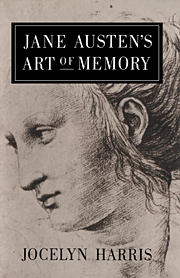Book contents
- Frontmatter
- Contents
- Preface
- 1 Northanger Abbey
- 2 The return to Richardson
- 3 Sense and Sensibility
- 4 Pride and Prejudice
- 5 Mansfield Park
- 6 Emma
- 7 Persuasion
- Conclusion: ‘Nothing can come of nothing’
- Appendix 1 The History of Sir Charles Grandison
- Appendix 2 Sir Charles Grandison in the juvenilia
- Notes
- Bibliography
- Index
3 - Sense and Sensibility
Published online by Cambridge University Press: 18 August 2009
- Frontmatter
- Contents
- Preface
- 1 Northanger Abbey
- 2 The return to Richardson
- 3 Sense and Sensibility
- 4 Pride and Prejudice
- 5 Mansfield Park
- 6 Emma
- 7 Persuasion
- Conclusion: ‘Nothing can come of nothing’
- Appendix 1 The History of Sir Charles Grandison
- Appendix 2 Sir Charles Grandison in the juvenilia
- Notes
- Bibliography
- Index
Summary
When Nancy Steele calls out ‘Oh, la! here come the Richardsons’(275), Jane Austen deftly allows that Sense and Sensibility is connected to Richardson's novels by a multitude of discoverable threads. Both as much-loved objects, and as artifacts already commentedon in the Barbauld edition of the Correspondence, they provided her with characters, scenes, and themes for this and the two other novels she published first.
Her knowledge of him ‘was such as no one is likely again to acquire’, said James Austen-Leigh with pardonable pride (p. 89), and like her brother, like her own mother, like Catherine Morland's mother, Jane Austen very often read Sir Charles Grandison.‘Every circumstance narrated in [it], all that was ever said or done in the cedar parlour, was familiar to her; and the wedding days of Lady [Grandison] and Lady G. were as well remembered as if they had been living friends’. Habitually she recalled the date of the year upon which episodes in the novel were supposed to have taken place, for Richardson's power of creating, and preserving the consistency of his characters, as particularly exemplified in “Sir Charles Grandison”, gratified the natural discrimination of her mind', says Henry Austen (p. 7). She helped a niece write a Grandison-based play, but seeing that it is not as close as her own novels to the original, it may not be primarily hers. Grandison was thus important to Jane Austen, but so were Clarissa and Pamela.
- Type
- Chapter
- Information
- Jane Austen's Art of Memory , pp. 48 - 83Publisher: Cambridge University PressPrint publication year: 1989



